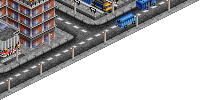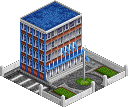|
Rail Building
Part 2: Stations
Stations are the most important part of any rail network. It is
best to have your station off the main line so there is no unnecessary
traffic passes through them causing delays for trains using the
station.
Platforms
The first thing you must consider when placing a station is how
much traffic it will receive. A station that serves a secondary
industry or a large town will receive more traffic than one that
services one small primary industry. Naturally, the more traffic
you expect your station to receive, the more platforms you should
build.
For low production primary industries, it is a matter of personal
opinion whether one platform is better than two as they both have
distinctive advantages and disadvantages.
Single platform stations at low production primary industries have
the advantage of controlling the interval between departures of
trains. Only one station can occupy the station at any given time
and any other trains must wait. This causes the period of time where
there is a train in the station to be greater than if there were
two or more platforms, aiding your station ratings. Secondly, single
platform stations reduce the likely hood of "rush hour"
periods in your network where many trains try to cram around your
secondary industry at once. This is because the intervals between
train departures at the station are spread out. Single platform
stations require less land and are easier to upgrade from rail to
monorail to maglev. They also allow better rotation of cargo, with
a first in, first out system being used instead of a random calculation
on which cargo leaves first.
The two biggest problems with single platform stations is they
have a low capacity. While this is OK for low production primary
industries, should the industry's production improve, another platform
must be added. The local authority may not allow this or the land
may be used by a competitor. Also, there is a greater need for overflow
control (see below). Pre-signals can not be used for overflow control
as trains may queue over the main line.
Should your station handle more than one cargo type or a large
output industry, then it's best to stick with mutable platform stations
due to their ability to handle up to 4 trains at once (7 with TTDPatch).
It is important that the train is not longer than the platform.
If it is, the back of the train could stick out the end of the station
and cause a red signal preventing any other trains from entering
the station. Also, trains that don't fit in the station take far
longer to load and unload than normal. Because of this, you should
make all stations the same length.
With TTDPatch, the maximum length of a station is 7 squares
Thanks to Adam Kudlubek for his contribution to the above section.
Train Movement
There are two ways the trains can move through your station. They
can go in and out the same way (as in a terminus station) or in
one way and out the other (as in a Ro-Ro station). It is highly
recommended that you set the "Train Reversing" option
in the Difficulty Level menu to "At End of Line Only."
If you set it to "At End of Line, or at Stations," you'll
have trains going the wrong way through your stations, which could
cause gridlock.
Terminus
As the name suggests, these are stations that are at the end of the
line. Trains go out the same way they came in. The biggest problem
with Terminus stations is that trains entering the station must wait
for trains leaving or vice versa, causing unnecessary delays. Because
of this, it's best to not use Terminus stations unless space is limited,
for example, in cities or mountainous regions.
Ro-Ro
Ro-Ro stands for Roll-On, Roll-Off (or
Roll In, Roll Out, depending who you ask) - trains roll
on from the bottom of the picture and roll off the station from the
top. The advantage these have over terminus stations is trains entering
the station do not have to wait for trains leaving. This is great
for stations that receive medium amounts of traffic because of it's
simplicity. It's no good for high-traffic stations (e.g., stations
serving factories, sawmills, food processing plants etc.) because
once all platforms are full, the train waits at the two way signal
for the platform closest to the entrance. This can lead to never-ending
grid-lock if that train is a goods, steel, paper or food train with
full load orders for that station. Note the use of two-way signals.
This is explained in Rail Fundamentals.
Overflow Control
The two designs above are great if there are only 2 or less trains
trying to use the station at any one time, but what happens when
a third train comes along? The third train sees both that two-way
signals are red so picks the closest one, and waits for that train
to depart. If the other platform is freed up before the one the
third train is waiting for, it will just sit empty. The third train
will only go to the first platform.
There are at least three ways to stop prevent this from occurring:
Loop Around
The first way is a loop around track. The idea behind this is if a
train enters the station and sees all the two way signals are red
(platforms are full) except the loop around track, it will take the
loop around track. This means instead of choosing a random platform
and stopping, it loops around and around and around. Every time it
loops around, it looks for a free platform. If it finds one, it takes
it, if not, it loops around again. The problem with this system is
other trains can zip in and steal the free platform while the first
train is looping around. Remember to make the looping track long enough
so it can fit at least one of your longest trains between the signal
at the start and the signal at the end.
Escape Depot
A second, less common but better way of controlling station overflow
is an "escape depot." This is where there is a depot in
the two-way/one-way signal set up at the entrance. Depots automatically
have a two way signal in them so behave just like a loop around track.
The advantages with an escape depot is, unlike loops, they have an
unlimited capacity.
With escape depots, you have to be careful where the depot and the
entrance is. There should be a depot at both ends of the two-way/one-way
signal set up at the station entrance, as shown in the picture.
Thanks to Adam
Kudlubek pointing out Cecile
Irgens' site and giving me that one.
Pre-Signals
Pre-signals are the most common and popular method. The advantage
is, unlike the above methods, pre-signal stations with one entrance
allow the first train to arrive when the station is full to take the
first free platform. The only problem is the queues of trains from
these can go over the main line and cause hold ups for trains not
going into the station. To solve this, you just need a long approach
to the station. Pre-signals are only available if you have TTDPatch. An explanation of how it works is found at Rail
Fundamentals.
Long Exits
Normally, when two trains leave a station at once, one must stop and
give way to the other. This leaves one train half in the station and
half out, leaving that platform unusable to any other trains trying
to enter the station. Long exits allow the train to pull out of the
station completely before it hits the red signal, freeing up the platform
for any trains on their way into the station. Note the length of the
exit track, 7 squares - the length of the longest train plus two more
squares, so the train can fit neatly between the signals.
Double Entrance
This is the type of design I use for stations that handle a huge
number of trains, such as the stations servicing factories or food
processing plants. They are a combination of many other ideas listed
in the site. This station can not be effectively built without TTDPatch. An explanation of the signals used in the picture can
be found at Rail Fundamentals.
There are a couple of things you should note about this design:
- The entrances to the two pre-signal blocks are positioned so the
tracks leading to the platform are closer to the entrance than the
joining track (with the "combo" signal). This is because trains
generally pick the closest available track when they all have two-way
signals and all lead to the station. Having trains going to the
other pre-signal block when there are available tracks in the first
block causes both blocks to be closed unnecessarily, reducing efficiency.
- The tracks between the pre-signal blocks and the station are one
square longer than required. This is so trains don't ever have to
slow down to make (unrealistic) ninety degree turns.
- If one entrance receives more traffic than another, it should have
a larger pre-signal block (in this case, 4 platforms compared 3
on the other block). It should also have the lesser number of tracks
merging after the station so trains face less delays as they exit.
Now we've got station design worked out, connect them. Next topic: Three Way Junctions
|






